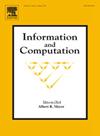Elastic-degenerate string comparison
IF 1
4区 计算机科学
Q3 COMPUTER SCIENCE, THEORY & METHODS
引用次数: 0
Abstract
An elastic-degenerate (ED) string T is a sequence of n sets containing m strings in total whose cumulative length is N. We call n, m, and N the length, the cardinality and the size of T, respectively. The language of T is defined as . Given two ED strings, how fast can we check whether the two languages they represent have a nonempty intersection? We call this problem the ED String Intersection (EDSI) problem. For two ED strings and of lengths and , cardinalities and , and sizes and , respectively, we show the following:
- •There is no -time algorithm, for any , for EDSI even if and are over a binary alphabet, unless the Strong Exponential-Time Hypothesis is false.
- •There is no combinatorial -time algorithm, for any and any function f, for EDSI even if and are over a binary alphabet, unless the Boolean Matrix Multiplication conjecture is false.
- •An -time algorithm for outputting a compact representation of the intersection language of two unary ED strings. When and are given in a compact representation, we show that the problem is NP-complete.
- •An -time algorithm for EDSI.
- •An -time algorithm for EDSI, where ω is the matrix multiplication exponent; the notation suppresses factors that are polylogarithmic in the input size.
弹性简并字符串比较
弹性简并(ED)字符串T是由n个集合T[1],…,T[n]组成的序列,其中总共包含m个字符串,其累积长度为n。我们将n, m, n分别称为T的长度,基数和大小。T的语言定义为L(T)={S1⋯Sn:Si∈T[i],对于所有i∈[1,n]}。给定两个ED字符串,我们可以多快地检查它们所代表的两种语言是否有非空交集?我们称这个问题为ED弦相交问题。对于长度n1和n2,基数m1和m2,大小分别为n1和n2的两个ED字符串T1和T2,我们展示了以下内容:•对于任何ϵ>;0,对于EDSI,即使T1和T2在二进制字母表上,也没有O((N1N2)1−λ)时间算法,除非强指数时间假设是假的。•对于任何ϵ>;0和任何函数f,对于EDSI,除非布尔矩阵乘法猜想为假,否则不存在组合O((N1+N2)1.2−ϵf(N1, N2))时间算法,即使T1和T2在二进制字母表上。•用于输出两个一元ED字符串的相交语言的紧凑表示的O(N1log (N1log)) n +N2log (N2log) n时间算法。当T1和T2以紧表示形式给出时,我们证明了问题是np完全的。•EDSI的O(N1m2+N2m1)时间算法。•EDSI的O ~ (N1ω−1n2+N2ω−1n1)时间算法,其中ω为矩阵乘法指数;O ~表示法抑制了输入大小中的多对数因子。
本文章由计算机程序翻译,如有差异,请以英文原文为准。
求助全文
约1分钟内获得全文
求助全文
来源期刊

Information and Computation
工程技术-计算机:理论方法
CiteScore
2.30
自引率
0.00%
发文量
119
审稿时长
140 days
期刊介绍:
Information and Computation welcomes original papers in all areas of theoretical computer science and computational applications of information theory. Survey articles of exceptional quality will also be considered. Particularly welcome are papers contributing new results in active theoretical areas such as
-Biological computation and computational biology-
Computational complexity-
Computer theorem-proving-
Concurrency and distributed process theory-
Cryptographic theory-
Data base theory-
Decision problems in logic-
Design and analysis of algorithms-
Discrete optimization and mathematical programming-
Inductive inference and learning theory-
Logic & constraint programming-
Program verification & model checking-
Probabilistic & Quantum computation-
Semantics of programming languages-
Symbolic computation, lambda calculus, and rewriting systems-
Types and typechecking
 求助内容:
求助内容: 应助结果提醒方式:
应助结果提醒方式:


